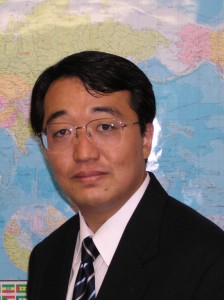緊張と統合:内村鑑三におけるキリスト教と日本の精神
このシリーズでは、私が1994年に執筆した統一神学大学院(Unification Theological Seminary)の神学課程修士論文(Divinity Thesis)を日英二か国語で掲載している。
今回から第3章の「無教会運動における司牧の概念」に入る。
3.無教会運動における司牧の概念
A.無教会の教会観
内村は1901年の3月に自ら発行した「無教会」と題する雑誌の発刊の辞の中において無教会の概念を定義しており、これは後にこの概念の理解にとって決定的なものとなった。
「無教会」と云へば無政府とか虚無党とか云ふやうで何やら破壊主義の冊子のやうに思はれますが、然し決してそんなものではありません。「無教会」は教会の無い者の教会であります。即ち家の無い者の合宿所とも云ふべきものであります。即ち心霊上の養育院か孤児院のやうなものであります。「無教会」の無の字は「ナイ」と訓むべきものでありまして、「無にする」とか、「無視する」とか云ふ意味ではありません。金の無い者、親の無い者、家の無い者は皆な可憐な者ではありません乎。さうして世には教会の無い、無数の羊が多いと思いますから、ここに此小冊子を発刊するに至ったのであります。
内村は論ずる。ある教会は石で、あるものはれんがで、またあるものは木で作られており、これらはみな人間の手によって作られたものである。しかし「無教会」信者にとっての教会は「神によって創られた宇宙であり、天然」である。「これが私ども無教会信者にとってのこの世界における教会であります。」したがって、
その天井(てんじょう)は蒼空であります。その板に星がちりばめてあります。その床(ゆか)は青い野であります。そのたたみはいろいろの花であります。その楽器は松のこずえであります。その楽人は森の小鳥であります。その高壇は山の高根でありまして、その説教師は神様ご自身であります。これが私ども無教会信者の教会であります。
無教会のキリスト教徒達は、「エクレシア」(ecclesia)と教会(church)との間には、基本的な区別があると考える内村の意見に同意する。語源学的に見て、「エクレシア」は信者の集まり、あるいは集会のことのいうのに対して、「教会」もしくは「キルヒェ」(Kirche)は寺院またはチャペル(たとえばギリシャ語の Kuriakon を参照)を意味する。無教会主義者は、キリストは前者すなわち非公式な霊的共同体を創られたのであって、巨大な組織制度を創ったのではないと信じている。キリスト御自身が、教派心の主たる特徴である律法主義や形式主義に強く反対されたのである。キリストはただ御自身に対する信仰を望まれたのであって、組織や種々の教義、あるいは信条に対する信仰を望まれたのではない。キリスト教の中にある教派的傾向は、排他的な態度をもってイエスを独占しようとした使徒達から始まったのである。かくして無教会は、教会発展の歴史に見られる基本的な誤りは、キリストとの交わりに一つの機関が(その組織、教義、礼拝儀式を伴って)とって代わったことであったと、結論を下すのである。
III. Concept of Ministry in Mukyokai Movement
A. The Mukyokai View of the Church
Uchimura defines the concept of Non-Church (Mukyokai) in the inaugural issue of his own journal titled “Mukyokai,” published in March 1901, which has become the definitive understanding of the concept:
‘No Church’ may sound like a concept dedicated to serve the cause of iconoclasm as are anarchism and nihilism. Far from it, ‘No Church’ is a communal shelter for the homeless. It is like a spiritual sanatorium or an orphanage. ‘No’ as in ‘No Church’ is in the sense of ‘without,’ and not of ‘nullifying’ or ‘ignoring.’ As there are many unfortunate folk without money, without parents, without a home, there are many sheep lost without a church. It is for these people that this journal is now offered.(1)
While some churches are made of stone, others of brick and yet others of wood, all by human hand, argues Uchimura, the church for the believers in the ‘No Church’ is “the universe created by God; it is of nature.” “This is the church in this world for us who believe in the ‘No Church’.” Therefore,
Its ceiling is the azure blue sky, adorned [at night] with bright stars. Its floor is the green pasture, dotted with flowers of infinite colors. Its musical instrument is the boughs of pine trees and its musicians are the birds in the forest. Its altar is the mountain peaks and its preacher is God himself. Such is the church for all of us who believe in the ‘No Church.’(2)
The Mukyokai Christians agree with Uchimura that there is a basic distinction between “ecclesia” and “church.” Etymologically, “ecclesia” refers to an assembly or congregation of Believers, whereas “church” or “Kirche” refers to a temple or chapel (cf. the Greek Kuriakon). The Mukyokai believe that Christ intended to create the former, an informal spiritual community rather than a major institutional system. Christ himself strongly opposed the legalism and formalism which are the chief characteristics of sectarianism. Christ wanted only faith in himself, not belief in an institution, dogmas, or creeds. Christian sectarianism began with the apostles, who wished to monopolize Jesus exclusively. Thus they conclude that the basic historical mistake in church development was the substitution of an institution (with its organization, creeds, and rituals) for the fellowship of Christ.(3)
(1)Uchimura, “No Church Described” (Mukyokai Ron), Mukyokai, I (March 1901), p.1. quoted by T. James Kodera, “Uchimura Kanzo and his ‘No Church Christianity’: its origin and significance in early modern Japan” in Religious Studies, 23 (September 1987), p.380.
(2)Ibid, p.2.
(3)Caldarola, p.50-53.
